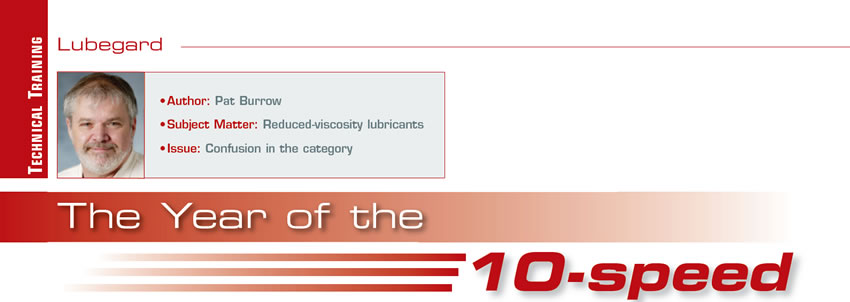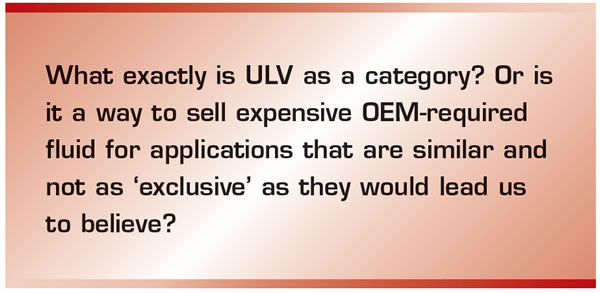
Technical Training
- Author: Pat Burrow
- Subject Matter: Reduced-viscosity lubricants
- Issue: Confusion in the category
When I first became aware of the fact that automatic transmissions had their own special fluid and it was red, I felt I had achieved the necessary level of technical knowledge to work the parts counter at the local automotive parts store. Forty-five years ago it was all that you needed to know. Fast forward to today and it’s gotten so complicated it is truly difficult to keep up, even when that’s what you do for a living. My latest example of OEM-driven confusion is the new crop of 10-speed automatic transmissions that have showed up this year.
Ten gear ratios seem to be a very popular solution to achieving final drive ratio spreads that amaze and provide new levels of efficiency. There are four versions of four-planet gearset 10-speed transmissions reaching a dealership near you soon and they are from different OEMs. Ford and GM co-developed the 10R80 and immediately slipped it neatly into their corporate pickup fleets for high-end, high-performance applications. Toyota has sourced the AWR10L65 for the 2018 Lexus LC and LS. Honda has developed a four-planet, 10-speed front-wheel-drive transmission (in house) for the V-6 engine 2018 Odyssey.
There are some milestones that endear me to these new technologies like the move to radial needle bearings in place of flat thrust washers, and a move to elimination of all sliding frictional wear components to roller type for improved efficiency and the ability to use reduced-viscosity lubricants. Masterpieces of engineering advances using high-strength low-weight materials (there are no cast iron components in these transmissions). The use of cutting-edge reduced-viscosity fluids was one of the technical improvements made in all pre-release technical articles from the OE development teams (Ford, GM, Aisin and Honda) designing these new four-planet, 10-speed transmissions. The lubricants specified for the new 10-speed transmissions will be “fill for life” (corporate policy requires this statement for some reason) and are a new category of ATF (their words) they are calling “Ultra Low Viscosity” or as Ford calls its proprietary fluid (waiting at the dealership for you) Ford ULV. This is where it all starts to get confusing. Let me explain.

Most OEMs use “optimized fluid engineering” (OE justification) to explain why every new addition to the corporate transmission lineup will require a new fluid designed specifically for that application. There was at one time a “corporate fluid” if you will, that was used for all automatic transmissions they made or used. It was corporate wide and there was one, maybe two, fluids per corporation. Then the notion of fluid as a profit center and extended warranties caused a huge proliferation of Original and OEM exclusive fluids to flood the market place.

With that said, my problem with the new 10-speed category of ULV fluid is not the fact it requires a special low-viscosity ATF of high quality. It is the exclusive nature of the category that concerns me. I have only looked at two of the four fluids that will certainly be required by each OEM. Enough issues from that alone gives rise to the question, what exactly is ULV as a category? Or is it a way to sell expensive OEM required fluid when the fluid requirements for all four planetary-design 10-speed automatic transmissions are similar and not as “exclusive” as they would lead us to believe?
I have to congratulate Ford and GM on agreeing to use ATF that is red. (There has been a move to automatic transmission fluids colors other than red, like blue and green.) When I saw that, I thought great, Ford and GM are starting to see the value of using the same fluid (MERCON and DEXRON used to be interchangeable). Then I started reading the specification sheets provided by GM for their required ATF (DEXRON HP) and the specification sheet for the required Ford ATF (MERCON ULV).
Everything was fine until I got to the kinematic viscosity of the ATF. Viscosity at 100° C. has been used for years as a major determiner of what transmission that fluid is suitable for. Four- and five-speed transmissions use an ATF of around 7.5 cSt at 100° C. Six-speed transmissions liked an ATF with a viscosity of 6.0 cSt at 100° C. (Centistoke: name of the viscosity measure used to determine the time it takes for a fluid to travel a given distance through a calibrated tube at specific temperatures like 40° C. and 100° C.) In the past these specific required kinematic viscosities (based on corporate engineering dictates) were a non-negotiable requirement for warranties based on fluids meeting the OE viscosity requirement.
The new “ULV” category called for by Ford and GM each calls for a different OEM ATF. Ford ULV with a viscosity of 4.5 cSt at 100° C. and DEXRON HP at 5.95 cSt at 100° C. (similar viscosity requirement to ATF for 6-speed applications). These required fluids, for what is essentially the same transmission, do not have the same viscosity requirement. Not only that, but this much deviation in viscosity from the OEM-required fluid in the past (1.45 cSt) would invalidate a warranty under corporate policy at a Ford dealership. If I put DEXRON HP in my 2018 Ford 10R80 RWD truck, is my warranty void?
It appears we have a new category with no consensus on what is the best way to go when it comes to viscosity at operating temperatures. In the past, a fluid this thin (4.5 cSt at 100° C.) was considered destructive to transmissions not designed for it. Maybe GM believes a ULV fluid needs to be more robust and favors a more high-performance approach. Ford, on the other hand, may be searching for fuel economy and wanted a “maximum-efficiency” solution. Different goals drive different outcomes. I guess we will have to wait and see what Toyota and Honda have in store for their 10-speed ATF fluid requirement. We do not even know what color it will be yet. Is there a new ATF ULV fluid category, or just more confusion and expensive dealer-only fluids? Welcome to the year of the 10-speed automatic transmission. I guess we will have to wait and see.














